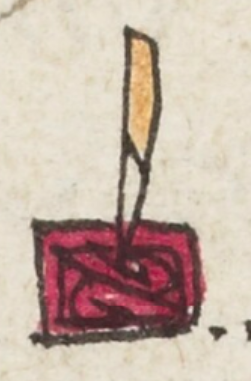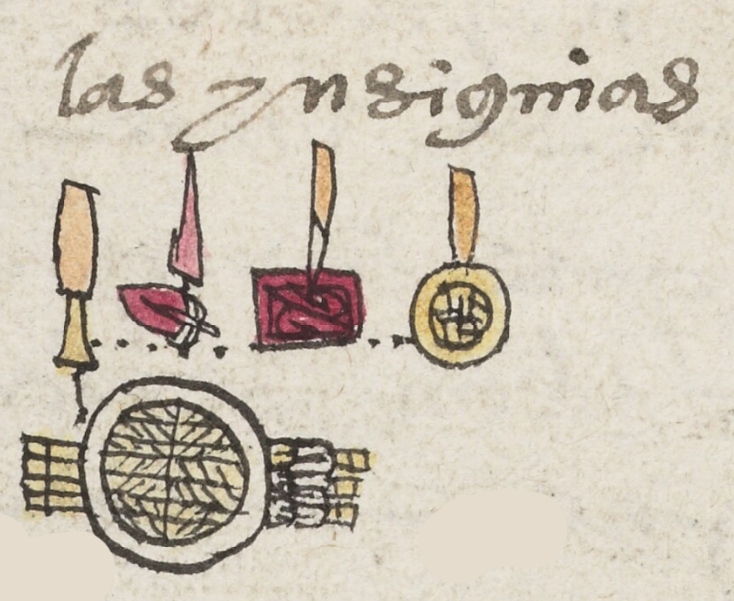tlacuiloque machiyotl (Mdz57r)
This example of iconography from folio 57 recto of the Florentine Codex shows one of four insignia (which we are here calling machiyotl, despite the lack of a gloss identifying them as such in Nahuatl). This one has an association with tlacuiloque in a study by Laura Filloy Nadal and María Olvido Moreno Guzmán, in their essay in Mesoamerican Manuscripts (2018, p. XVI). They explain that these insignia refer to "carpenters (cuahxinque), featherworkers (amanteca), painters (tlacuiloque), and goldsmiths (teocuitlahuaque)." See the contextualizing image to get a view of all four insignia. The one singled out here is a red box with two opposing speech scrolls and a two-tone, white and tan writing implement above them. The colors are divided on a diagonal. This is the one the authors associate with writers.
Stephanie Wood
There is a strong likelihood that this sign refers to the act of writing or painting, or perhaps even something painted or written. Beyond that, several scholars have concluded that this is a very specific piece of writing, a day (ilhuitl) from the divinatory almanac, the tonalamatl. See the discussions associated with our records for tlacuilo and tlacuiloliztli (below).
Marc Thouvenot identifies the verb icuiloa (or ihcuiloa, with the glottal stop), which means to paint, write, or print, as having a root of -cuil-. He notes how it also appears in tlacuiloliztli (writing), tlacuilo (writer), and cuicuiltic (mottled). He goes on to show various uses of icuiloa that take it beyond the simple definitions just given, resulting in something like the action of creating a design (e.g., on leather, ceramics, sculpture, or in textiles). It can also be something like the action of decorating (e.g., to put a flower on a cup of atole). He associates icuiloa and tlacuilolli with "cultural artifacts," such as arts and crafts or examples of writing and painting, but cuicuiltic with effects created by "nature." This short summary barely does his article justice; it is worth reading the entire piece. How Thouvenot's study might connect with the concept of bent or curved mentioned by Prem (1974: 555, 682) raises an interesting question. Perhaps the bent or curved lines of writing, painting, carving, embroidery, and so on, fall with in the realm of expressions of -cuil-. See
Marc Thouvenot, "Imágenes y escritura entre los nahuas del inicio del XVI," Estudios de Cultural Náhuatl 41 (2010).
Stephanie Wood
las ynsignias
las insignias
Stephanie Wood
c. 1541, or by 1553 at the latest
Stephanie Wood
insignias, signos, símbolos, escritura, pintura, escritores, pintores

tlacuilo, writer or painter, ihui(tl), feather, https://nahuatl.wired-humanities.org/content/tlacuilo
machiyo(tl), sign, insignia, etc., https://nahuatl.wired-humanities.org/content/machiyotl
tlacuiloliz(tli), the act of writing, https://nahuatl.wired-humanities.org/content/tlacuiloliztli
ihui(tl), feather, https://nahuatl.wired-humanities.org/content/ihuitl
insignia de los escribanos y pintores
Stephanie Wood
Codex Mendoza, folio 57 recto, https://digital.bodleian.ox.ac.uk/objects/2fea788e-2aa2-4f08-b6d9-648c00..., image 124 of 188.
Original manuscript is held by the Bodleian Libraries, University of Oxford, MS. Arch. Selden. A. 1; used here with the UK Creative Commons, “Attribution-NonCommercial-ShareAlike 3.0 License” (CC-BY-NC-SA 3.0)






